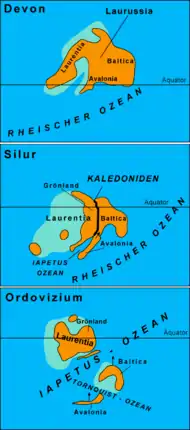Rheic Ocean
The Rheic Ocean was an ocean which separated two major palaeocontinents, Gondwana and Laurussia (Laurentia-Baltica-Avalonia). One of the principal oceans of the Palaeozoic, its sutures today stretch 10,000 km (6,200 mi) from Mexico to Turkey and its closure resulted in the assembly of the supercontinent Pangaea and the formation of the Variscan–Alleghenian–Ouachita orogenies.[1]
Etymology
The ocean located between Gondwana and Laurentia in the Early Cambrian was named for Iapetus, in Greek mythology the father of Atlas (from which source the Atlantic Ocean ultimately gets its name),[2] just as the Iapetus Ocean was the predecessor of the Atlantic Ocean. The ocean between Gondwana and Laurussia (Laurentia–Baltica–Avalonia) in the Late Cambrian-Early Ordovician was named the Rheic Ocean after Rhea, sister of Iapetus.[1][3]
Geodynamic evolution

At the beginning of the Paleozoic Era, about 540 million years ago, most of the continental mass on Earth was clustered around the south pole as the paleocontinent Gondwana. The exception was formed by a number of smaller continents, such as Laurentia and Baltica. The Paleozoic ocean between Gondwana, Laurentia and Baltica is called the Iapetus Ocean. The northern edge of Gondwana had been dominated by the Cadomian orogeny during the Ediacaran period. This orogeny formed a cordillera-type volcanic arc where oceanic crust subducted below Gondwana. When a mid-oceanic ridge subducted at an oblique angle, extensional basins developed along the northern margin of Gondwana.[4] During the late Cambrian to Early Ordovician these extensional basins had evolved a rift running along the northern edge of Gondwana.[5] The rift in its turn evolved into a mid-oceanic ridge that separated small continental fragments such as Avalonia and Carolina from the main Gondwanan land mass.
As Avalonia-Carolina drifted north from Gondwana, the Rheic Ocean grew and reached its maximum width (4,000 km (2,500 mi)) in the Silurian. In this process, the Iapetus Ocean closed as Avalonia-Carolina collided with Laurentia and the Appalachian orogeny formed.[6]
The closure of the Rheic began in the Early Devonian and was completed in the Mississippian when Gondwana and Laurentia collided to form Pangaea. This closure resulted in the largest collisional orogen of the Palaeozoic: the Variscan and Alleghanian orogens between Gondwana's West African margin and southern Baltica and eastern Laurentia and the Ouachita orogeny between the Amazonian margin of Gondwana and southern Laurentia.[6]
See also
- Morais ophiolite complex – A metamorphic complex of oceanic and continental crust terranes in Portugal
 Oceans portal
Oceans portal
Sources
References
- Nance et al. 2010, Introduction
- "How was the Atlantic Ocean named?". World Atlas. Retrieved 27 July 2020.
- Murphy et al. 2006, Introduction
- Scenario from Linnemann et al. 2008
- Murphy et al. 2006; Linnemann et al. 2007
- Murphy et al. 2006, Evolution of the Rheic Ocean; Fig. 4
Bibliography
- Linnemann, U.; Pereira, F.; Jeffries, T. E.; Drost, K.; Gerdes, A. (2008). "The Cadomian Orogeny and the opening of the Rheic Ocean: The diacrony of geotectonic processes constrained by LA-ICP-MS U–Pb zircon dating (Ossa-Morena and Saxo-Thuringian Zones, Iberian and Bohemian Massifs)". Tectonophysics. 461 (1–4): 21–43. Bibcode:2008Tectp.461...21L. doi:10.1016/j.tecto.2008.05.002.CS1 maint: ref=harv (link)
- Linnemann, U.; Gerdes, A.; Drost, K.; Buschmann, B. (2007). "The continuum between Cadomian Orogenesis and opening of the Rheic Ocean: constraints from LA-ICP-MS U–Pb zircon dating and analysis of plate-tectonic setting (Saxo-Thuringian Zone, NE Bohemian Massif, Germany)" (PDF). In Linnemann, U.; Nance, D.; Kraft, P.; et al. (eds.). The Evolution of the Rheic Ocean: from Avalonian–Cadomian Active Margin to Alleghenian–Variscan Collision. Geological Society of America Special Paper. 423. pp. 61–96. doi:10.1130/2007.2423(03). ISBN 9780813724232. Retrieved 21 November 2015.CS1 maint: ref=harv (link)
- Murphy, J. B.; Gutierrez-Alonso, G.; Nance, R. D.; Fernandez-Suarez, J.; Keppie, J. D.; Quesada, C.; Strachan, R. A.; Dostal, J. (2006). "Origin of the Rheic Ocean: Rifting along a Neoproterozoic suture?". Geology. 34 (5): 325–328. Bibcode:2006Geo....34..325B. doi:10.1130/G22068.1. Retrieved 21 November 2015.CS1 maint: ref=harv (link)
- Nance, R. D.; Gutiérrez-Alonso, G.; Keppie, J. D.; Linnemann, U.; Murphy, J. B.; Quesada, C.; Strachan, R. A.; Woodcock, N. H. (2010). "Evolution of the Rheic ocean". Gondwana Research. 17 (2): 194–222. Bibcode:2010GondR..17..194N. doi:10.1016/j.gr.2009.08.001. Retrieved 21 November 2015.CS1 maint: ref=harv (link)
External links
- Website of the PALEOMAP Project
- Middle Silurian paleoglobe showing the expanding Rheic Ocean
- Early Carboniferous paleoglobe showing the almost disappeared Rheic Ocean